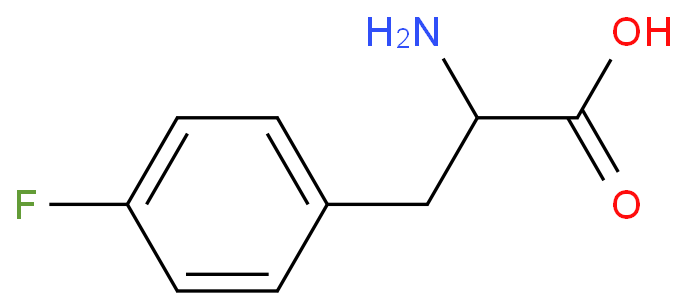-
4-FLUORO-DL-PHENYLALANINE
- CAS:60-17-3
- MW:183.179603
- MF:C9H10FNO2
1. Names and Identifiers
- 1.1 Name
- 4-FLUORO-DL-PHENYLALANINE
- 1.2 Synonyms
- 2-azanyl-3-(4-fluorophenyl)propanoic acid; 3-(4-Fluorophenyl)-2-aminopropionic acid; 3-(p-fluorophenyl)-alanin; 4-Fluoro-DL-tyrosine; 4-FLUOROZN-DZTL-PHENYLALANINE; ALANINE,3-(PARA-FLUOROPHENYL)-; p-FPhe;
- 1.3 CAS No.
- 60-17-3
- 1.4 CID
- 4654
- 1.5 EINECS
- 200-459-9
- 1.6 Molecular Formula
- C9H10FNO2
- 1.7 Inchi
- InChI=1S/C9H10FNO2/c10-7-3-1-6(2-4-7)5-8(11)9(12)13/h1-4,8H,5,11H2,(H,12,13)
- 1.8 InChkey
- XWHHYOYVRVGJJY-UHFFFAOYSA-N
- 1.9 Canonical Smiles
- C1=CC(=CC=C1CC(C(=O)O)N)F
- 1.10 Isomers Smiles
- C1=CC(=CC=C1CC(C(=O)O)N)F
2. Properties
- 2.1 Solubility
- less than 1 mg/mL at 70° F (NTP, 1992)
- 2.2 Decomposition
- When heated to decomposition it emits toxic vapors of /nitrogen oxides and fluorides/.
- 2.3 Water Solubility
- less than 1 mg/mL at 70° F (NTP, 1992)
3. Safety and Handling
- 3.1 Octanol/Water Partition Coefficient
- log Kow = -1.08 (est)
- 3.2 Cleanup Methods
- SRP: Wastewater from contaminant suppression, cleaning of protective clothing/equipment, or contaminated sites should be contained and evaluated for subject chemical or decomposition product concentrations. Concentrations shall be lower than applicable environmental discharge or disposal criteria. Alternatively, pretreatment and/or discharge to a POTW is acceptable only after review by the governing authority. Due consideration shall be given to remediation worker exposure (inhalation, dermal and ingestion) as well as fate during treatment, transfer and disposal. If it is not practicable to manage the chemical in this fashion, it must meet Hazardous Material Criteria for disposal.
- 3.3 DisposalMethods
- SRP: The most favorable course of action is to use an alternative chemical product with less inherent propensity for occupational exposure or environmental contamination. Recycle any unused portion of the material for its approved use or return it to the manufacturer or supplier. Ultimate disposal of the chemical must consider: the material's impact on air quality; potential migration in soil or water; effects on animal, aquatic, and plant life; and conformance with environmental and public health regulations.
4. MSDS
2.Hazard identification
2.1 Classification of the substance or mixture
no data available
2.2 GHS label elements, including precautionary statements
| Pictogram(s) | no data available |
| Signal word | no data available |
| Hazard statement(s) | no data available |
| Precautionary statement(s) | |
| Prevention | no data available |
| Response | no data available |
| Storage | no data available |
| Disposal | no data available |
2.3 Other hazards which do not result in classification
no data available
5. Computed Properties
- Molecular Weight:183.179603g/mol
- Molecular Formula:C9H10FNO2
- Compound Is Canonicalized:True
- XLogP3-AA:183.06955672
- Monoisotopic Mass:183.06955672
- Complexity:179
- Rotatable Bond Count:3
- Hydrogen Bond Donor Count:2
- Hydrogen Bond Acceptor Count:4
- Topological Polar Surface Area:63.3
- Heavy Atom Count::13
- Defined Atom Stereocenter Count:0
- Undefined Atom Stereocenter Count:1
- Defined Bond Stereocenter Count:0
- Undefined Bond Stereocenter Count:0
- Isotope Atom Count:0
- Covalently-Bonded Unit Count:1
- CACTVS Substructure Key Fingerprint:AAADccByMQAAAAAAAAAAAAAAAAAAAAAAAAAwAAAAAAAAAAABAAAAHwAQCAAADCjBmAwwCIBAAgCIAiDSCAACAAAgAAAIiIGAAIgKIDKAkRGAYAAkkAAIiAeYyKCOAAAAAAAAAAAAAAAAAAAAAAAAAAAAAA==
-
Tel:
Update Time:2024/06/17
-
Tel:
Update Time:2019/02/25
-
Tel:
Update Time:2019/11/25
-
Tel:
Update Time:2022/01/01
7. Related Questions
8. Realated Product Infomation

 EN
EN
